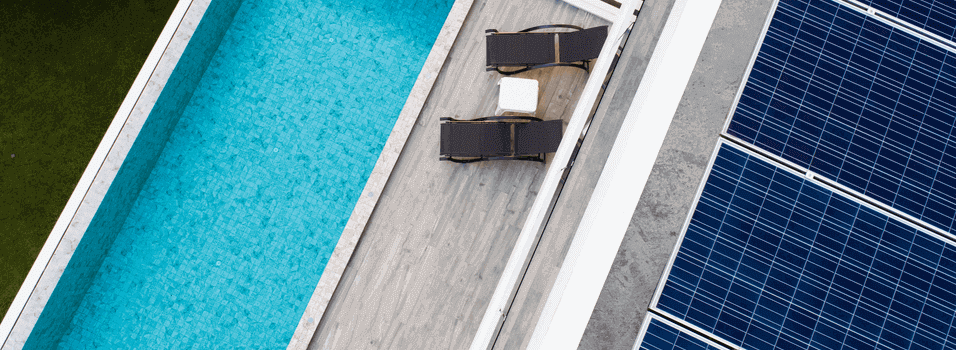Some companies claim that homeowners can save up to 17% off their electricity bill if they swap their grid-connected pool pump to solar only. Canstar Blue investigates the feasibility of switching to solar pool pumps.
A new backyard swimming pool can significantly increase quality of life, especially during the hotter months. However, once house guests depart, cabana huts are cleaned and the pool area is vacant the focus eventually shifts to running costs like electricity bills.
This Canstar Blue guide explores the potential costs and savings from running solar pool pumps, plus whether they are worth installing.
On this page:
Advertisement
What is a solar pool pump?
Like a conventional grid-connected pool pump, a solar pool pump is used to circulate and filter the water in your pool. It filters out harmful bacteria and dirt or debris after sucking water through skimmers. Purified liquid is then returned to the pool. Heaters, salt chlorine generators and other accessories can also be added.
One key difference between grid-connected and solar pool pumps is that a solar pump is connected to between four and six solar panels, meaning it cannot operate without sunlight. In comparison, grid-connected pool pumps always run, except for during outages, and can be connected to a timer that only turns on at night when electricity is cheaper.
Solar pool pump kits usually come with a solar pool pump, cartridge pool filter, controller, solar panel array and other accessories that convert sunlight into photovoltaic (PV) energy.
How does a solar pool pump work?
Solar pool pumps work by drawing water from the pool through the skimmers and drains, removing large debris in the process. When the water reaches the pump’s impeller, the pressure forces the water through a filter, catching debris that wasn’t removed by the skimmer baskets.
After the debris has been removed, water is treated (and sometimes heated – depending on the system) before being returned to the pool.
Solar pool pumps are very cost-effective because they run off PV energy that is freely provided by the sun. Once systems have been purchased and installed operating costs can practically reduce to nil, delivering total monthly electricity savings of up to 17%.
Most grid-connected pumps are incompatible with solar pump systems and must be replaced. They do not work even when connected to solar panels. There is also no way to connect solar power pumps to the grid, which can cause delays during wet weather when solar energy production drops.
Fortunately, installing a home solar system that uses some PV power for pool pumps can provide the best of both worlds. Although this solution has a greater upfront expense it will deliver even greater savings. A 6 kW system or greater is recommended and pool pump timers should be set to run between 11am and 1pm in winter as well as 10am to 3pm during summer.
How many solar panels does it take to run a pool pump?
Determining exactly how many solar panels to install depends on different factors.
These may include:
- water capacity
- size of the solar panels
- size and shape of the pool
- energy produced by solar panels
- number of hours the pump runs for
- pool type (above ground or in-ground)
- how much power the solar pump requires.
Knowing the solar pool pump wattage can more easily help determine how many solar panels are needed to power solar pool pumps compared with only finding the average wattage output of solar panels. Dividing the pump wattage by panel wattage output can indicate roughly how many panels are needed. A licensed solar installer or pool professional can more accurately recommend solutions for your circumstances.
Between four and six solar panels can effectively power solar pumps in pools containing up to 90,000 litres. Pumps can be adjusted to operate more frequently during the summer months when solar panels generate more electricity.
Can I convert my pool pump to solar?
Transitioning from grid-connected pool pumps to solar pool pumps is a complex process.
Directly connecting pool pumps to a few solar panels will not work. The closest alternative involves plugging the pump into an electrical outlet that is supplied by a home solar system.
Several accessories are required to make AC pool pumps compatible with solar panels, but these can cost more than simply buying a new DC solar pool pump.
DC pool pumps are easier to install because they do not require an inverter in order to draw energy directly from solar panels. Seeking professional advice is the best way to ensure the system will work correctly and not cost more in the long run.
Offsetting grid power expenses is also possible through running the pool pump on solar energy from a home solar power system. Pumps can still technically run on solar power and avoid being entirely replaced, especially when they still work well. One potential downside is the existing pool pump will still consume electricity from the grid during wet weather or whenever solar energy production is low.
Compare solar plans and prices
Here are some of the cheapest solar-specific deals from the retailers on our database. These costs are based on the Ausgrid network in Sydney but prices will vary depending on your circumstances. We show one product per retailer, listed in order of lowest price first. Annual price estimates assume general energy usage of 3900kWh/year for a residential customer on a single rate tariff. Price estimates exclude solar feed-in tariff credits. These are products from referral partners†. Our database may not cover all deals in your area, and please check retailer websites for up to date information.
Here are some of the cheapest solar-specific deals from the retailers on our database. These costs are based on the Citipower network in Melbourne but prices will vary depending on your circumstances. We show one product per retailer, listed in order of lowest price first. Annual price estimates assume general energy usage of 4000kWh/year for a residential customer on a single rate tariff. Price estimates exclude solar feed-in tariff credits. These are products from referral partners†. Our database may not cover all deals in your area, and please check retailer websites for up to date information.
Here are some of the cheapest solar-specific deals from the retailers on our database. These costs are based on the Energex network in Brisbane but prices will vary depending on your circumstances. We show one product per retailer, listed in order of lowest price first. Annual price estimates assume general energy usage of 4600kWh/year for a residential customer on a single rate tariff. Price estimates exclude solar feed-in tariff credits. These are products from referral partners†. Our database may not cover all deals in your area, and please check retailer websites for up to date information.
Here are some of the cheapest solar-specific deals from the retailers on our database. These costs are based on SA Power network in Adelaide but prices will vary depending on your circumstances. We show one product per retailer, listed in order of lowest price first. Annual price estimates assume general energy usage of 4000kWh/year for a residential customer on a single rate tariff. Price estimates exclude solar feed-in tariff credits. These are products from referral partners†. Our database may not cover all deals in your area, and please check retailer websites for up to date information.
How much do solar pool pumps cost?
Supplying and installing an entire solar pool pump system can cost between $2,000 and $5,000, according to Solar Choice. Kits usually include a solar pool pump, solar panels, labour fees and other essential accessories that help ensure smooth operation.
Solar pool pumps themselves are usually very cost effective components, ranging between $200 and $800. Solar panels are the most expensive parts, costing between $1,400 and $3,500. Installation fees depend on system capacity, location and obstacles. Solar rebates are available to help cover installation and other upfront costs.
Achieving a return on investment usually takes between two and five years. This calculation is based on the average single-speed pool pump running for eight hours a day at an annual cost of about $420 according to My Perfect Pool’s cost calculator. This equates to an annual energy cost saving of around $1,020.
Remember that solar pool pumps have a two or three year warranty while solar panels are guaranteed to last for a decade. Try to factor in the cost of replacing solar pool pumps once when estimating how long recovering initial costs will take.
Solar pool pumps pros and cons
There are several major benefits of installing a solar pool pump. Solar pool pumps do not need to be attached to the grid, which means they will run less frequently if less solar energy is generated. This also means receiving a solar feed-in tariff for excess solar generated is impossible.
Installation does not require approval from the local energy grid because the solar pool pump is off the grid. These solar panels can be mounted on the ground, pool shed, garage or anywhere which saves valuable roof space. They also do not count towards the maximum number of grid-connected solar panels.
Summer tends to be sunnier than winter months and pools are more likely to be used when the weather is hotter. Therefore, pumps consume more electricity and work harder during the busier months.
Solar pool pumps will run as long as the sun shines. They are immune to grid outages because they are not connected. Therefore, blackouts will not affect them.
One limitation is the solar panels last much longer than the solar pool pump, which will eventually need to be replaced and increase the length of time needed to make a return on investment.
Another point to consider is whether your property has enough room to mount up to six bulky solar panels. Although some flexibility exists, they cannot fit in very confined spaces.
Are solar pool pumps worth it?
If saving money is your long-term goal, solar pool pumps can be very cost-effective after paying upfront expenses.
Using an existing home solar system to power a grid-connected pool pump can achieve similar results too. Sometimes this option can save more money because unused electricity generated can be fed back into the grid and attract a feed-in tariff, which is not possible when solar pool pumps are installed.
Check out Canstar Blue’s annual customer satisfaction ratings for recommended solar installers. Find brands that consumers have rated top-notch in the field.
Compare Best-Rated Solar Installers
Image credits: NAS CREATIVES/Shutterstock.com




Share this article